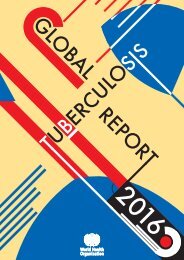patients
DNDi_AR_2015
DNDi_AR_2015
Create successful ePaper yourself
Turn your PDF publications into a flip-book with our unique Google optimized e-Paper software.
PAEDIATRIC HIV<br />
R&D MODEL & PORTFOLIO<br />
What are the current treatments and their limitations?<br />
The 2013 WHO guidelines recommend early diagnosis and immediate treatment of HIVpositive<br />
infants and children under the age of five, regardless of immunological status; infants<br />
under the age of three should be treated with an antiretroviral treatment (ART) combination<br />
that includes protease inhibitors, regardless of whether they have been exposed to ARVs, for<br />
the prevention of mother-to-child transmission (PMTCT).<br />
The combination of a boosted protease inhibitor (PI) with two nucleoside reverse transcriptase<br />
inhibitors (NRTIs), ABC + 3TC or ZDV + 3TC, is considered by the WHO as the most effective<br />
first-line therapy for infants and children.<br />
However, this combination therapy is not being widely used. According to a WHO survey<br />
performed in 45 countries, in 2010 only 12.2% of children with HIV were receiving a first-line<br />
treatment containing lopinavir/ritonavir (LPV/r), 97% of whom were in South Africa. The only<br />
available PI for young children, LPV/r, does not come in a child-friendly formulation: the oral<br />
solution is unpalatable, contains 42% alcohol, and is not adapted to resource-poor settings<br />
due to major logistical constraints: it requires refrigeration, has a short shelf-life when<br />
exposed to heat, is expensive, and difficult to store and transport.<br />
In some places, the levels of co-infection with TB and HIV in infants and children are high.<br />
Drug-drug interactions between PIs in particular and rifampicin, one of the drugs used to<br />
treat TB greatly diminish the blood levels of PIs and hinder the efficacy of the antiretroviral<br />
(ARV) treatment. In order to counteract this interaction, extra ritonavir (RTV) needs to be added<br />
to the standard proportion of LPV/r. This is called ‘superboosting’. The currently available<br />
ritonavir formulation suffers the same limitations as the current formulation of RTV with<br />
regard to taste, high alcohol content, and logistical constraints imposed by its short shelf-life.<br />
2.6 million<br />
children<br />
below the age of 5<br />
living with HIV/AIDS<br />
More than 86%<br />
of all new infections in<br />
sub-Saharan Africa<br />
150,000<br />
children<br />
under 15 years of age<br />
died of AIDS-related<br />
illness in 2014<br />
globally<br />
WHAT IS DNDi DOING TO ADDRESS UNMET TREATMENT NEEDS?<br />
In 2010, DNDi was called on by various<br />
organizations, including Médecins Sans<br />
Frontières, WHO, and UNITAID, to apply<br />
its expertise to the development of<br />
paediatric HIV treatments. DNDi’s position,<br />
notably that paediatric HIV is a neglected<br />
disease, was published as a ‘Perspective’<br />
in the New England Journal of Medicine<br />
in August 2011.<br />
DNDi is pursuing two objectives to address<br />
the needs of HIV-infected children:<br />
1. Develop and register two solid first-line<br />
‘4-in-1’ LPV/r-based fixed-dose<br />
combinations (FDCs) with two NRTIs.<br />
All components of the combination will<br />
be developed in the form of tastemasked<br />
granules, which are stable with<br />
no need for refrigeration, presented in a<br />
single unit with appropriate strengths to<br />
accommodate weight band dosing.<br />
2. Evaluate the superboosting strategy:<br />
i.e. increasing the LPV:RTV ratio that<br />
can effectively and safely counteract<br />
the negative drug-drug interactions<br />
between PIs and rifampicin-containing<br />
TB treatments.<br />
As a short-term strategy, DNDi will start<br />
testing the use of PI-based treatment with<br />
Cipla’s LPV/r-based pellets before the<br />
‘4-in-1’ FDC becomes available, in order<br />
to provide better treatment for infants<br />
today and promote in-country adoption.<br />
DNDi participated in the CHAPAS-2 trial<br />
that compared LPV/r pellets to the LPV/r<br />
liquid formulation. These pellets are being<br />
used in combination with NRTI dispersible<br />
tablets in implementation studies (LIVING<br />
study), which started in 2015. In the<br />
longer-term, DNDi is working with Cipla,<br />
its industrial partner, on combining<br />
taste-masked LPV/r granules or pellets<br />
with two NRTIs into a single unit dose.<br />
This modular concept is flexible, so that<br />
any of the components can eventually be<br />
substituted to provide new fixed-dose<br />
combinations.<br />
In order to address the needs of HIV/TB<br />
co-infected children, DNDi aims to assess<br />
the addition of ritonavir for superboosting<br />
LPV/r at a 1:1 LPV:RTV ratio. DNDi is<br />
conducting a study to establish the<br />
pharmacokinetics, efficacy, and safety of<br />
superboosted LPV/r in children in South<br />
Africa with the existing ritonavir solution.<br />
Interim results look promising for this<br />
approach and the study is being extended<br />
to include all solid formulations.<br />
The ideal first-line treatment for<br />
paediatric HIV would be a protease<br />
inhibitor-based all-in-one antiretroviral<br />
regimen for HIV-infected children which<br />
is safe and efficacious, is an adapted<br />
formulation suitable for infants and<br />
children, is an easy-to-use fixed-dose<br />
combination, is palatable, addresses<br />
drug-drug interaction with medicines for<br />
tuberculosis, and is adapted to tropical<br />
climates (no refrigeration needed).<br />
By 2019, DNDi aims to deliver<br />
from its paediatric HIV portfolio:<br />
• Two new ‘4-in-1’ paediatric<br />
formulations containing a PI<br />
(LPV/r) and two NRTIs (ABC or<br />
AZT and 3TC)<br />
• One new regimen<br />
recommended to treat<br />
HIV/TB coinfection<br />
DNDi Annual Report 2015 › 45



